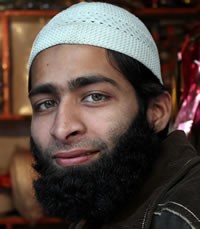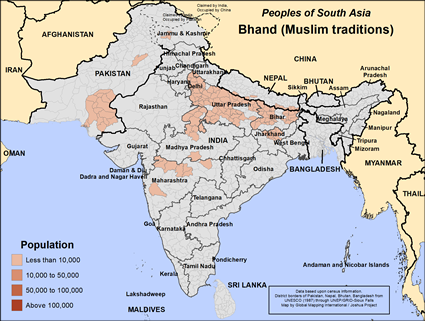Bhand (Muslim traditions) in Pakistan

Photo Source:
Copyrighted © 2025
Michael E All rights reserved. Used with permission |

Map Source:
People Group data: Omid. Map geography: UNESCO / GMI. Map Design: Joshua Project
|
| People Name: | Bhand (Muslim traditions) |
| Country: | Pakistan |
| 10/40 Window: | Yes |
| Population: | 4,500 |
| World Population: | 47,300 |
| Primary Language: | Sindhi |
| Primary Religion: | Islam |
| Christian Adherents: | 0.05 % |
| Evangelicals: | 0.05 % |
| Scripture: | Complete Bible |
| Ministry Resources: | Yes |
| Jesus Film: | Yes |
| Audio Recordings: | Yes |
| People Cluster: | South Asia Muslim - other |
| Affinity Bloc: | South Asian Peoples |
| Progress Level: |
|
Introduction / History
The Bhand or Bhanr people get their name from the term in Sanskrit for 'jester' or bhanda. They are an occupational lower caste people who have been singers, dancers, actors and jesters since the days of feudal Kingdoms in India.
What Are Their Lives Like?
Today the Bhands are still known for their singing, dancing and storytelling in many areas of north and central India. The Damaleh Bhand in India are especially known for their folk-dance, folk-music and playing of the drum and flute. Most Bhand, however, can be found to have left their traditional occupation and moved into small business selling of household goods or toys.
Literacy is very low, and many children are not able to attend school though the boys often attend some Islamic instruction.
What Are Their Beliefs?
The Bhands are Sunni Muslim.
What Are Their Needs?
Because of their prominent traditional position in the community in performing, the Bhand community ought to be more open to outside communication and likely the gospel. Few have ever approached the Muslim Bhand in Nepal with the gospel and consequently there are no known believers.
Prayer Points
Pray for loving workers to go to the Bhand people, and for their hearts to be ready to receive their savior.
Pray for families of believers loving and serving others to grow reproducing churches.
Pray for a chain reaction of families reaching families that result in thousands of new disciples who share their faith with others.
Pray for grace and truth expanding into their entire society as all believers learn to love others.